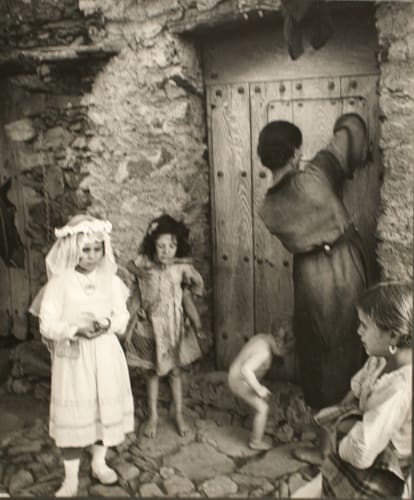Bruce Silverstein is pleased to announce The Art of History, an integral survey of artist
W. Eugene Smith's rare works. W. Eugene Smith's artful renderings of earnest subjects have made him known throughout the world as the preeminent authority of photojournalism and originator of the photographic essay. During his fruitful career Smith displayed an unwavering commitment to photography, its communication of events and their often complex emotions.
Dating back to his beginnings as a young photographer for the Wichita Eagle, Smith had a ravenous appetite for capturing the news of the day. His determination to bear witness to the historical events of the period placed Smith among the company of other politically minded photographers of the time including Walker Evans and Dorothea Lange. Like Lange and Evans, Smith worked against the current of genteel pictorialism then popular throughout America and Europe, and instead honed in on the humanist tragedies of the time, using his camera as the great raconteur.
Smith's passion for documentation was surpassed only by his passion for the expression of artistry. Thought of primarily as a journalist before an artist, any close examination of Smith's work and working methods reveals much the opposite to be true. Smith possessed a unique awareness of the power held within the image and its ability to articulate not only the physical moment as impressed upon the film, but the underlying web of emotions and implications as well. Despite his moral adherence to the accuracy and truthfulness of documentation, Smith at times manipulated the elements within the frame, the visual focus while printing, and the chronology of the works while sequencing his essays. This flexibility was born out of Smith’s desire to faithfully convey the feeling of the scene with the same rigor as the event itself. The voracity with which Smith employed directorship while shooting the images was matched by his endurance once printing them in the darkroom. Smith often used enhanced bleaching processes, and severe cropping to remove or draw attention to various subjects and themes in his essays. This emphasis on manipulative techniques, and Smith’s adherence to the presentation of his work in essay form allowed his images to exemplify moods and sentiments never before seen in photojournalism—illustrating the universal human experience which pervades each of his photographic essays regardless of their content, location or date.
The Art of History will present a unique opportunity to see the work of a master photojournalist in the context of the contemporary gallery setting, finally freeing the images from the bonds of text which normally surrounds them. This show will include a group of over fifty prints, many of which come from a private collection amassed before Smith’s death in 1978, and have been unseen for the last 30 years. Additionally included will be alternate views of Smith’s most well known works, illustrating the notion that Smith’s photographs occupied that rare space between document and art.
Smith’s work can be found in the collections of the Los Angeles County Museum of Art, the Smithsonian American Art Museum, the Museum of Fine Arts, Houston, and the San Francisco Museum of Modern Art, among others. His work has been widely exhibited at noteworthy institutions including the Center for Creative Photography, the Jewish Museum, New York, the Carnegie Museum of Art, the Centre Georges-Pompidou, and the Fotomuseum Winterhur. Most recently, Smith's series Dream Street was the subject of an exhibition at the International Center of Photography.

